Leapin’ lizards! Some of the McDermott Interns celebrated Leap Day by putting a little spring in our step, following the footsteps of past interns and staff inspired by Jumping in Art Museums…
Source: Leaping for Leap Day
Official behind-the-scenes blog of the Dallas Museum of Art
Leapin’ lizards! Some of the McDermott Interns celebrated Leap Day by putting a little spring in our step, following the footsteps of past interns and staff inspired by Jumping in Art Museums…
Source: Leaping for Leap Day
Leapin’ lizards! Some of the McDermott Interns celebrated Leap Day by putting a little spring in our step, following the footsteps of past interns and staff inspired by Jumping in Art Museums. You don’t need to wait another four years to join the fun–the next time you stop by the Museum, take your own jumping photos (from a safe distance of course!) and share them on Twitter or Instagram!

Reaching for the stars in front of Rufino Tamayo’s El hombre (Man).

It was just a hop, skip and a jump to Robert Rauschenberg’s Skyway.

Our love for Barbara Hepworth’s Sea Form (Atlantic) grew by leaps and bounds.

One small step for man, one giant leap for Mark Di Suvero’s Ave.
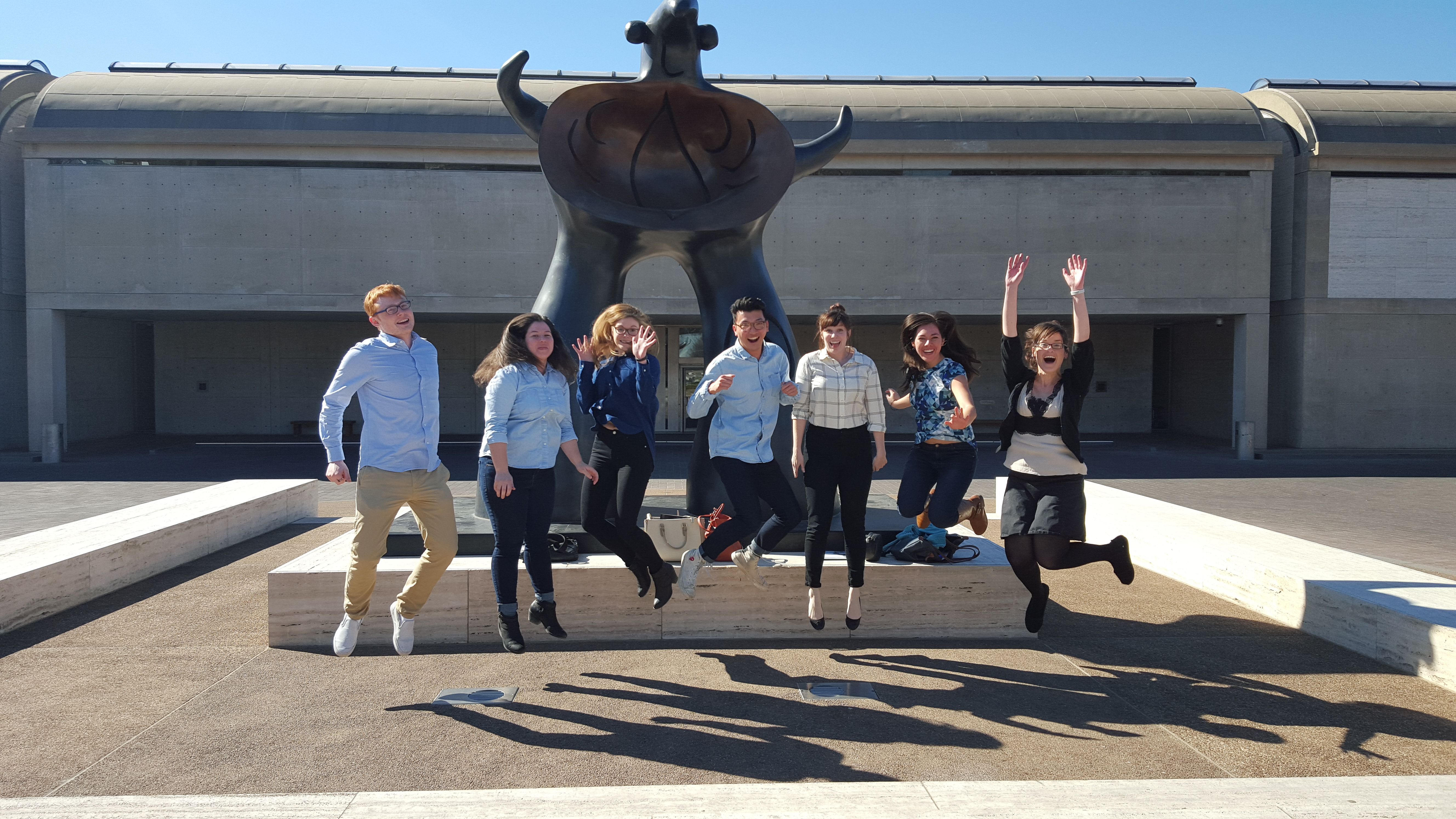
Jumping for joy in front of the Kimbell Art Museum.
We came to get down, we came to get down, so come to the Museum and jump around!
Arworks shown:
Paulina Lopez
McDermott Graduate Intern for Visitor Engagement
Whitney Sirois
McDermott Graduate Intern for Gallery and Community Teaching
Emily Wiskera
McDermott Graduate Intern for Family and Access Teaching
Last week, the Metropolitan Museum of Art in New York opened an exhibition dedicated to Elisabeth Louise Vigée-Lebrun, the 18th-century painter and favorite portraitist of Queen Marie-Antoinette. This exhibition, Vigée Le Brun: Woman Artist in Revolutionary France , brings together eighty paintings and pastels produced over the course of the artist’s career. It is the first retrospective and only the second exhibition dedicated to this important artist. But you don’t have to travel all the way to the Big Apple to see one of her paintings. The DMA is fortunate to have a portrait by Vigée-Lebrun hanging in our European Galleries on Level 2 as part of the Michael L. Rosenberg Collection.
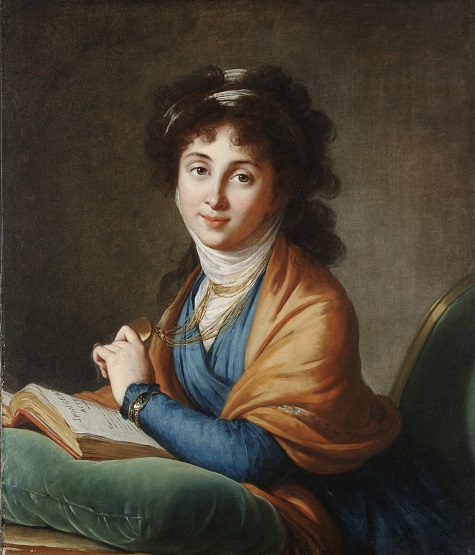
Elisabeth Vigée-Lebrun, Portrait of Madame Nakharovna, née Hitrova, 1799, oil on canvas, Dallas Museum of Art, The Michael L. Rosenberg Collection, 29.2004.13
Portrait of Madame Nakharovna, née Hitrova, painted in 1799, depicts a member of the Russian nobility. She is portrayed as a wealthy and educated woman, reading the play Iphigenia by Racine in French and wearing fashionable clothing and jewelry. The artist accentuates the translucent fabric of her scarf and the gold strands of Madame Nakharovna’s necklace as they catch the light. She creates a sense of spontaneity and interaction with the sitter, who seems to respond to our presence.
Because of her close association with Marie-Antoinette and the French monarchy, Vigée-Lebrun left France during the Revolution and spent six years in Russia, living in exile in St. Petersburg and Moscow. She was very successful in Russia as a portrait painter to the imperial family and the Russian nobility. She found many clients, such as Madame Nakharovna, eager to be painted by the favorite portraitist of the late queen of France.
Beyond success as an artist, Vigée-Lebrun seemed to have found, in the distant lands of Russia, the kind of life she had enjoyed in Paris. In her memoirs she wrote, “Every evening I went out. There were innumerable balls, concerts, and theatrical performances, and I thoroughly enjoyed these gatherings, where I found all the urbanity, all the grace of French company. It seemed as though good taste had made a jump with both feet from Paris to St. Petersburg.”
But the allure of Russian society didn’t stop her from lamenting the frigid winters: “I am perhaps the only person, who not suspecting how cold it was, ever took it into my head to pay a visit when the thermometer was at eighteen. . . . Everyone wears velvet, fur-lined boots in his carriage, and cloaks lined heavily with fur.”
So bundle up and come to the DMA to see Portrait of Madame Nakharovna by Elisabeth Vigée-Lebrun.
Franny Brock is the Dedo and Barron Kidd McDermott Graduate Intern for European Art at the DMA.
We’ve all heard about the importance of STEM–science, technology, engineering, and math–to our education system in a technology-focused world, but what about the creative thinking that goes hand-in-hand with these subjects? With this in mind, the Rhode Island School of Design began a push to include art, transforming STEM to STEAM. As an educator, you can find many great STEAM resources here at the Dallas Museum of Art!
For several years, DMA Education Staff and our group of STEAM Docents have been working together to develop and test STEAM tours and activities for multiple three-hour long visits by eighth grade students from Irma Rangel Young Women’s Leadership School. Themes for their visits include Art and Innovation, Design, Engineering, Conservation, and Nature and Art.
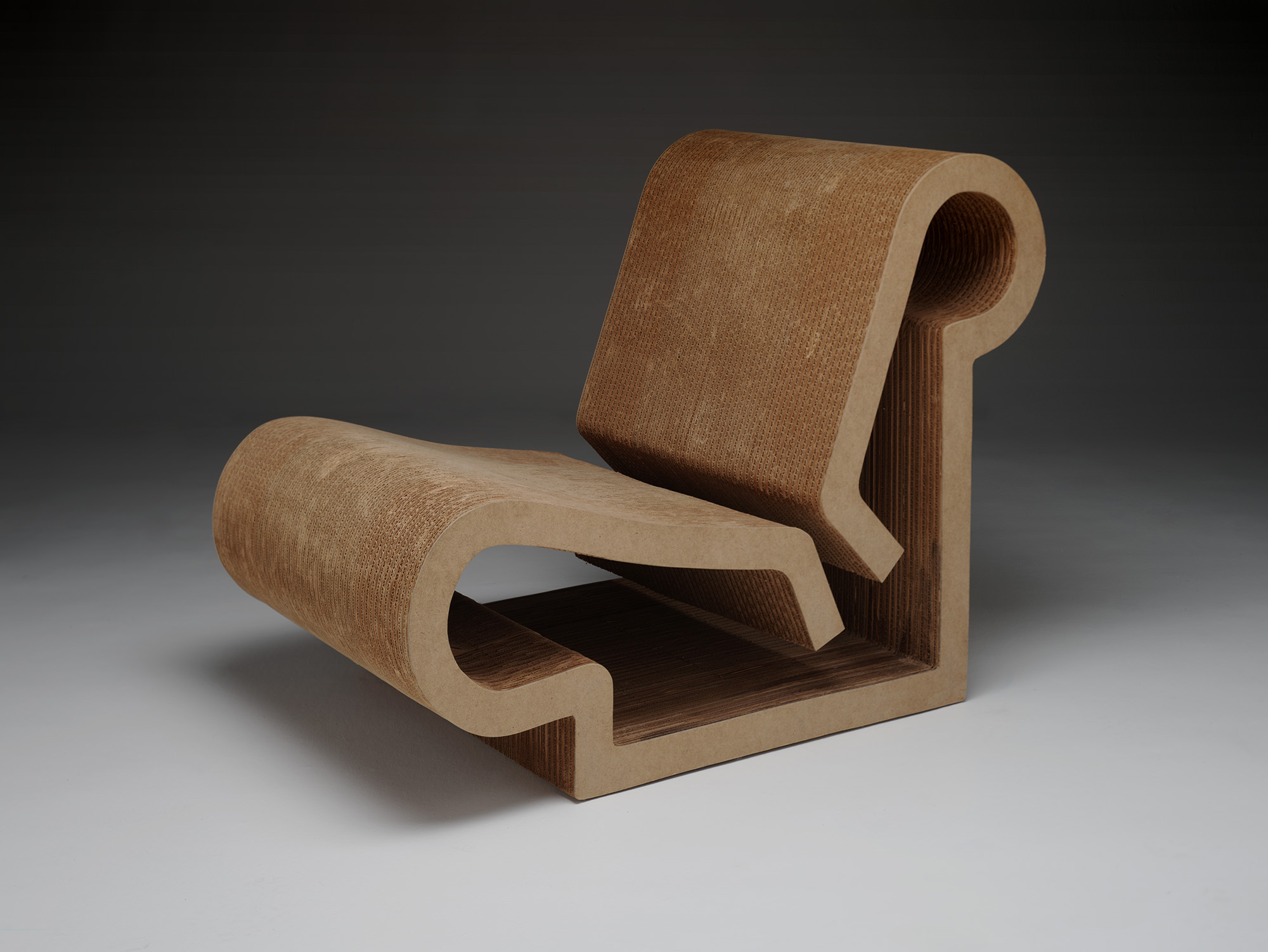
Frank O. Gehry, “Easy Edges” chair, 1971, Dallas Museum of Art, 20th-Century Design Fund
The objective of their time at the Museum is to emphasize the connections between art, science, technology, engineering and math, especially in how artists and scientists invoke similar practices and ideas. One of their visits explores the innovative design of Frank Gehry’s “Easy Edges” chair. Students learned how Gehry layered corrugated cardboard to a two inch thickness to create an object that is aesthetically pleasing while still maintaining the ability to support considerable weight.
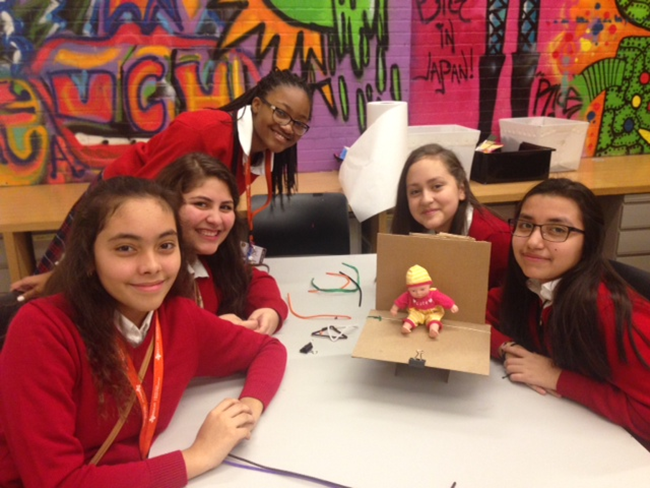
Rangel students creating a cardboard chair that can hold the weight of a doll, inspired by Frank Gehry’s “Easy Edges” chair. The catch? No glue or tape!
Two of our amazing STEAM docents, Susan Behrendt and Susan Fisk, asked their Rangel students the following question to see what they had learned about STEAM:
How does ART relate to STEM (Science, Technology, Engineering, Mathematics)? How do they relate to you?
Art relates to STEM because as you think and make the art you have to think about all of the things in STEM. Carefully analyzing the piece and including those things make it more eye catching. They relate to me because the art makes a study. – Genesis, May 2014
Art relates to STEM because we use it everywhere and it’s used to describe some of the events in history. Because of art we know far past back in history. We have to know all of these subjects for a good education. – Gallea, May 2014
Art is in everything. An example is geometry. Geometry incorporates art, science, and math. Another example is architecture. Architecture uses art, math, and engineering. It relates to me because I want to be an architect. – Isabella, May 2014
This spring, we lead our first STEAM in-service training for 170 art teachers from Fort Worth ISD, and released a comprehensive STEAM guide to our docent team. You can schedule a docent-guided tour or a teacher in-service yourself, and come explore the many connections between art and STEM here at the Museum!
Lindsay O’Connor
Manager of Docent and Teacher Programs
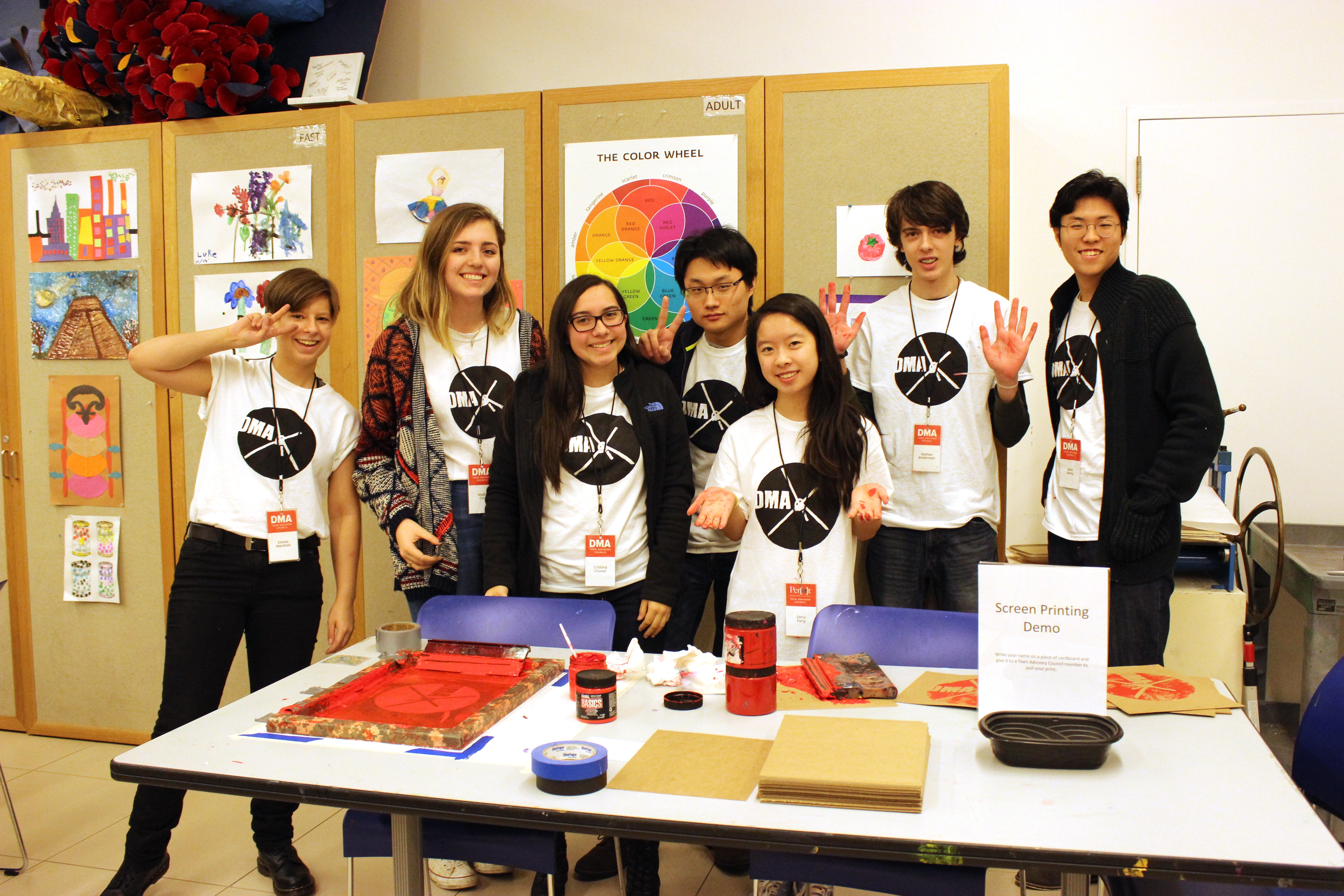
The Teen Advisory Council (or TAC for short!) was created to extend engagement and involve the teen perspective in creating new artistic experiences for visitors. We currently have fourteen members: Shirui, Won, Mo, Emma, Nathen, Carson, Maddi, Christina, Bethany, Taylor, Claire, Nikki, Riya, and me, Jierui. Our mentor, Jessica Thompson, is the Manager of Teen and Gallery Programs at the DMA.
Founded in 2014, the TAC has been involved in a variety of endeavors at first with JC Bigornia at the helm. On our first project, we partnered with the Perot Museum of Nature and Science and artist Brittany Ransom to create a window panel mural celebrating the fusion of the arts and sciences. The mural featured a tableau of microscopic views of everyday objects.

Our next stop was a partnership with Big Thought through their City of Learning program with the goal of preventing summer education loss. In a series of Turn Up events, our booth created a My Dallas Is… board (inspired by the Before I Die Wall) to better understand our fellow residents’ perspectives on our city. Later, Eliel Jones, a former McDermott intern, engaged us in his Experiments on Public Space project. The resulting Alternative Signage performance art piece used cardboard signs to break the barriers between the public and the Museum.

The June 2015 Late Night marked our biggest involvement with the Museum as we planned tours, haiku slams, scavenger hunts, speaker talks, and other superhero themed activities. Lastly, our most recent January Late Night Creations workshop with Jessica returned to our interest in the intersection of the arts and sciences. We used LED lights in conjunction with batteries to illuminate beloved works of art from the DMA’s permanent collection.
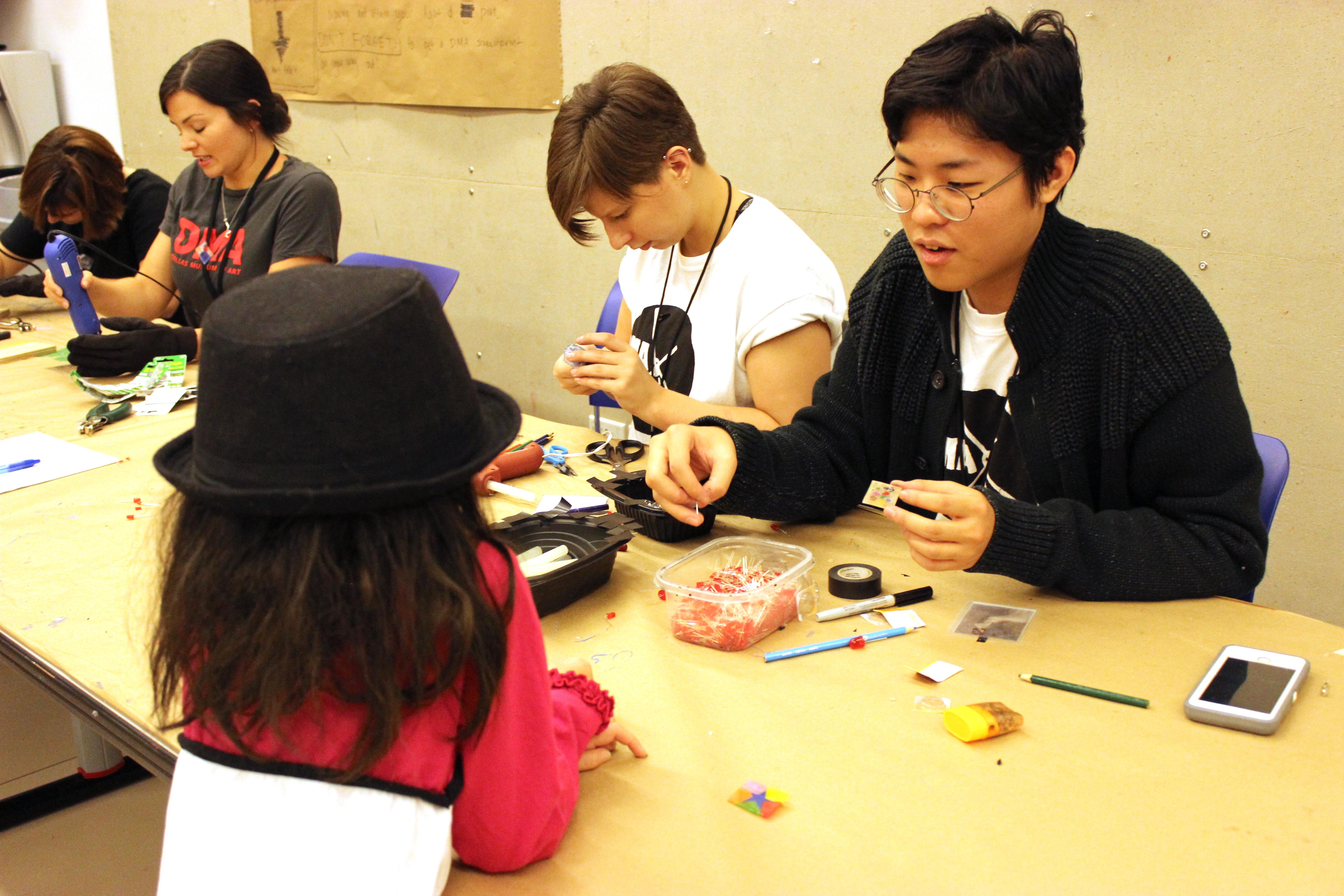
So what’s in store for the TAC? Your next chance to hear from us–after reading our lovely introduction to the blogosphere–is at our February Late Night Creations workshop entitled Rest On Your Laurels on February 19th. Join us as we celebrate your individual virtues and vices in the spirit of Classical tradition! We are also in the process of planning a teen workshop and other programs in the community. Although we may be relatively young, we are excited to add our mark to the vibrant canvas of the DMA!
Until next time!
Jierui Fang
Teen Advisory Council member
Love is in the air at the DMA! This Valentine’s weekend, DMA visitors shared their love for a favorite work of art in The Center for Creative Connections (C3) by participating in #HeartsForArt. Museums across the country invited visitors to place a paper heart on the floor in front of their most beloved work of art, then spread the love by photographing their art crushes and sharing them on Instagram or Twitter. At C3, visitors who tagged their photos with #HeartsForArt #DMAC3love were able to see favorite artworks on the #DMAdigitalspot wall of monitors.
Which are the most beloved DMA works of art in C3? We tallied up all of the #heartsforart time on Valentine’s Day to find that visitors have a soft spot for the DMA’s contemporary pieces. Jack Piersen’s Anytown USA (2000) was the most treasured artwork of the weekend, coming in at 106 hearts. The runners-up for Most-Loved artworks in C3 were Red and Yellow, Black and White (1982) by Vernon Fisher at 61 hearts, and Marcel Dzama’s The Minotaur (2008) at 58 hearts.
Paulina Lopez is the McDermott Graduate Intern for Visitor Engagement at the DMA
Move over Beyoncé and Jay-Z. Step back Kim and Kanye. The Adam and Eve couples of Valentine’s Day have been at this game for a while. If you happen to ask them for relationship advice, watch out—their knowledge on the subject seems to go back to the beginning of time itself. This couple has been through a lot together—from temptation to family drama—but they learned to love each other no matter what befell them. Their higher connections will probably get them excellent reservations at the most desired restaurants as well.
Here come the new kids on the block, spending their first Valentine’s Day together. In their eyes they are the sun and the moon, and they will do absolutely anything for each other. At this point in their relationship, chivalry and romance is rampant, and Sunday will be a test of their affection. Much like the Muslim Princess Erminia disguised herself as a knight to find her precious Christian Knight Tancred during the Crusades, their love knows no bounds. These are the couples you will see around town undertaking grandiose gestures like renting hot air balloons, or casually forsaking their families, homeland, and religion for the love of another.
The #Relationship Goals
Dinner at 5, home by 7, and in bed by 9. This couple’s unconditional love is something to aspire to. Much like the god Shiva and his wife, the goddess Parvati, shown here entwined in a passionate embrace, this couple might partake in too much PDA, but it’s acceptable due to how perfect they are for each other. This couple does not need to go to elaborate lengths this Valentine’s Day, because every day is a chance for them to do an act of kindness for the other.
The fear of being alone and celebrating Single Awareness Day led these individuals to take to dating apps to find their special someone. Much like the uncomfortable scene depicted here, you will find these forced couples in painfully awkward attempts at conversation. Some will try to woo their Valentine with their musical prowess, while others will rely on their good looks, lack of clothing, and charm. One or both members of the party may look to you in desperation, but remember it was they who chose to swipe right.
Julie Henley is the Communications and Marketing Coordinator at the DMA
Here at the DMA, we owe a lot to our wonderful volunteers. They give of their time and talent to help lead student visits, access programs, and adult group visits. Oftentimes, they’re the public face of the Museum, welcoming our visitors and helping them make meaningful connections with the works of art. The DMA simply would not be as special as it is without them!
In honor of Valentine’s Day, I asked our amazing team of docents which works of art from the DMA’s collection they especially love to share with our visitors.
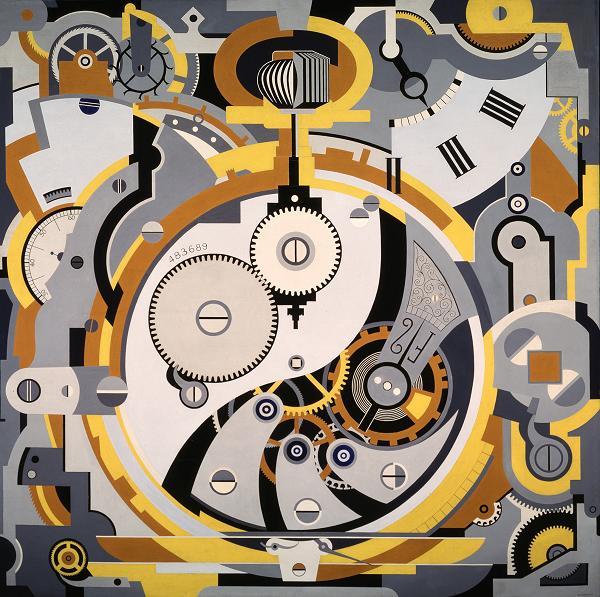
Gerald Murphy, Watch, 1925, Oil on Canvas, Dallas Museum of Art, Foundation for the Arts Collection, gift of the artist
One of my favorite paintings is Watch by Gerald Murphy. That was a magic time in Paris when painters, writers, and musicians worked together and inspired each other. The Murphys were a fascinating couple and his hard edge, hyper realistic paintings of everyday objects influenced later artists. He painted briefly, and out of about a dozen works, we own two, given to us by Murphy himself. There are letters from him about the gift in our archives. -Diane Roberts
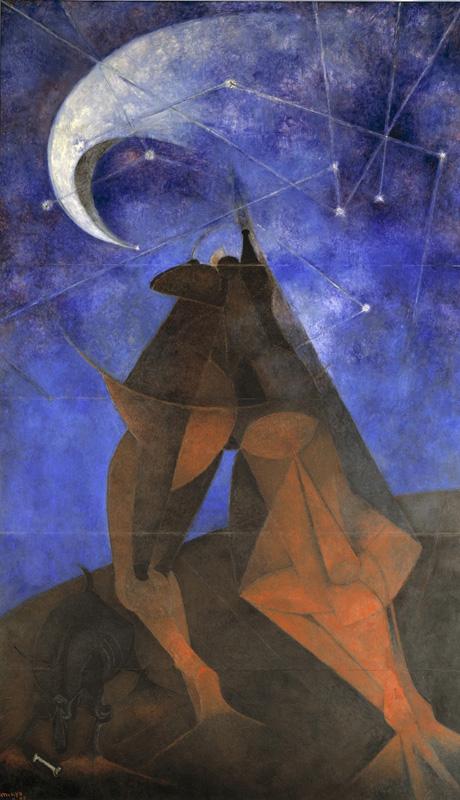
Rufino Tamayo, El Hombre (Man), 1953, Vinyl with Pigment on Panel, Dallas Museum of Art, Dallas Art Association commission, Neiman-Marcus Company Exposition Funds [credit line published in 1997 DMA Guide to the Collections: Dallas Museum of Art, commissioned by the Dallas Art Association through Neiman-Marcus Exposition Funds
I have a long standing love affair with Rufino Tamayo’s El Hombre. I use it 4-5 times a month, maybe more often than that. I wrote a paper in graduate school on its acquisition by and significance to the DMA. I use it interactively on my tours to teach three ways of looking at art: eyes, mind, and heart. – Kelly Breazeale
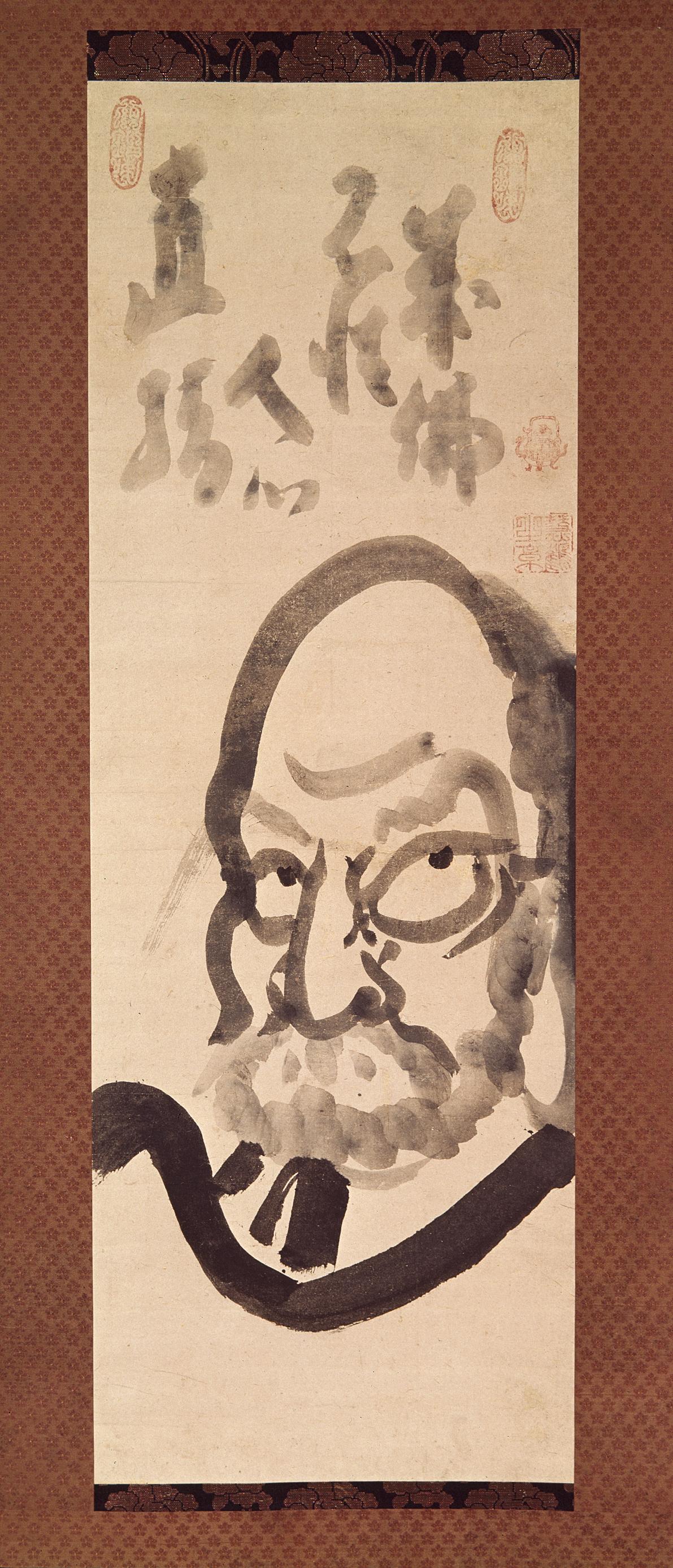
Daruma, Hakuin Ekaku, n.d., Ink on Paper, Dallas Museum of Art, General Acquisitions Fund
My new favorite work of art is the Daruma scroll by the Zen priest Hakuin Ekaku, because I love the simplicity and the meaning behind this form of art. The idea that it expresses the “true or formless self” appeals to me and some of my personal beliefs. Before I came to the Museum, I didn’t like or respect the work of Jackson Pollock, but after our session about him and his work, I gained a small glimpse of what he and his work are about. Then after hearing the lecture from Devon last week about the Zen Buddhist art, it began to make sense to me. I think that the Daruma scroll with its cartoon like appearance would appeal to children. I also think it would be fun for them to try their hand at drawing a picture in the style of the scroll. – Penny Hardy
Be sure to check out some of our docent’s favorite works, and many more, at the Dallas Museum of Art. Happy Valentine’s Day!
Lindsay O’Connor
Manager of Docent and Teacher Programs

For the last few months here at the DMA, we’ve been proclaiming “Pollock for all!” From toddlers to teens, and grade schoolers to grannies, the exuberant and lyrical works of “Action Jackson” have inspired thoughtful discussions, messy art, and even a dance performance! As a museum educator, one of the things I love most about Pollock’s work is his approach to putting paint on a canvas by splattering, flinging, dripping, and dropping (a process we often refer to as action art). When you have a bunch of squirmy three year-olds, Pollock makes all kind of sense! But Jackson Pollock: Blind Spots goes beyond Pollock’s all-over paintings and explores a body of work known as the black pourings, in which Pollock’s trademark action is tightly controlled, sweeping and swooping over the canvas to create figures that almost seem to be hiding amidst black lines, puddles, and splatters.
The exhibition has inspired all kinds of Pollock-ing in the studio, proving that no matter how old or young you are, Pollock is for all ages! Read on for some Pollock-inspired ideas you can try at home.

Babies
Our Art Babies class wiggled and giggled our way through the Pollock exhibition, then enjoyed sensory play inspired by the artist’s work. Pollock’s all-over paintings often remind me of a tangle of lines, with one line twisting and turning over another, so I created a sensory bin of “Pollock lines” for the little ones to explore. One little guy couldn’t get enough of throwing fistfuls of “noodles” into the air as high as he could. Recreate this at home with a large bin of either plastic cording or cooked spaghetti noodles (follow this helpful DIY recipe). But remember, since babies tend to put everything in their mouths, this activity does require grown-up supervision!

Toddlers and Preschoolers
If you are feeling brave, suit up your children in their messiest clothes, cover the floor with a drop cloth (or paint outside), and let them go to town, dribbling and splattering paint onto paper. If that idea has convinced you that Pollock is not for you, here are some less messy alternatives.
Marble painting is a fun way to get a feel for the energy and action Pollock might have used, while containing the mess. Place a piece of paper and a marble in a large box or box top, squeeze puddles of paint onto the paper, then have your child tip and shake the box back and forth to roll the marble through the paint. In no time at all, you’ll have a Pollock-ing, rollicking masterpiece.
Or if you want to avoid paint all together, substitute markers, yarn, and contact paper for the messy stuff. Have your child throw, dribble or drop pieces of yarn onto a piece of paper to create some Pollock-like lines. Cover the entire piece of paper with clear contact paper to seal the yarn in place. Then use colored markers (permanent works best on the contact paper) to create puddles of color. Pollock’s Convergence served as our inspiration for this project, and the children loved the layered effect.

Elementary & Middle School
The Pollock exhibition at the DMA features an entire gallery of paintings Pollock created on paper rather than canvas. We tried a similar approach using Japanese paper, droppers, and liquid watercolor. Layer two or three sheets of paper together, then gently move the dropper around the paper, squeezing watercolor as you go. Watch as different colors swirl and puddle together, then separate the individual pieces of paper to discover what images have soaked through.
Teens
At a recent Late Night event, we used scribble bots to create a modern take on Pollock’s work. All you need is a plastic cup, a toy motor, a battery, and a brush to make your own painting robot! The motor sends the robot skittering across the paper, and the paintbrush “captures” the movement in visual form. Download step-by-step instructions here: Scribble Bot Instructions.

Any Age
This final project is as mess-free as you can get! And it provides the most amazing results. Since November, we’ve been privileged to be a part of the Dance for Parkinson’s Disease program. We’ve hosted a wonderful group of individuals who have regularly visited the Museum galleries, and, under the direction of Misty Owens, choreographed a dance performance inspired by Jackson Pollock. As part of the choreography process, the group created light graffiti using laser pointers, flash lights, and a DSLR camera. It’s like painting in the air! This tutorial gives some great tips on creating your own light graffiti. To see Pollock in dance form, join us for the Dance for PD performance in the Center for Creative Connections on Friday, February 19 at 2:00 p.m.
So are you convinced? Ready to join our “Pollock for the People” crusade? We’d love to see what Pollock inspires you to do. Share your Pollock creations on social media with #DallasSpotsPollock and tag us @DallasMuseumArt.
Leah Hanson
Manager of Early Learning Programs
We’re celebrating the Year of the Monkey by highlighting a few works featuring the animal of the hour. Some of the monkeys are out in the open, but for others it takes a little more detective work to spot them in the paint. Happy Chinese New Year!
Kimberly Daniell is Senior Manager of Communications, Public Affairs, and Social Media Strategy at the DMA.